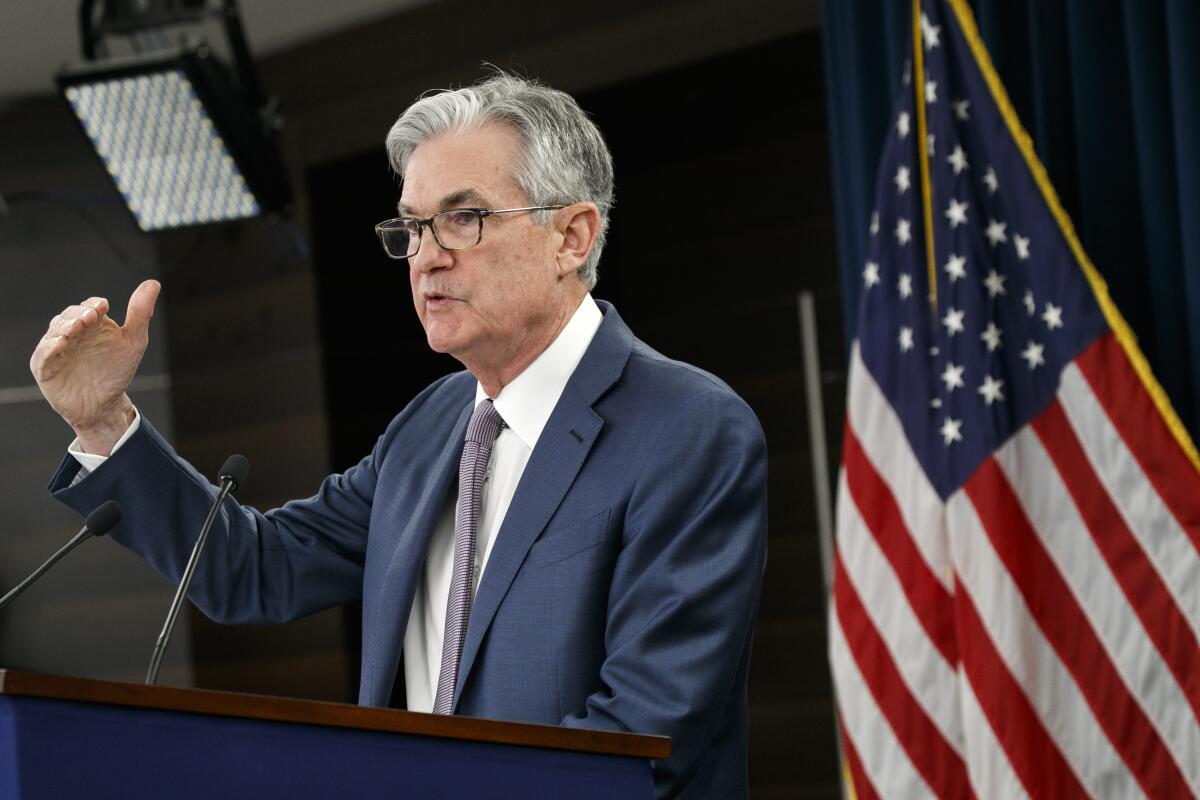Fed plans to keep interest rates low, even if inflation rises: Who stands to benefit?

- Share via
WASHINGTON — The Federal Reserve is likely to keep interest rates at rock bottom for even longer than previously expected after a major policy shift that has profound implications for Wall Street, workers and savers.
Fed Chairman Jerome H. Powell said Thursday that the central bank would now tolerate a higher level of inflation than in the past, when policymakers have lifted rates preemptively to head off a potentially overheating economy marked by rising consumer prices and falling unemployment.
Powell said the new approach reflects the reality that potential economic growth has slowed and that the threat of high inflation has diminished over the years, even when unemployment is low. For more than a decade, the annual inflation rate has consistently undershot the Fed’s 2% target.
In rethinking the trade-off between inflation and unemployment, the Fed decided to put more weight on maximizing employment, including what Powell called “our appreciation for the benefits of a strong labor market, particularly for many in low- and moderate-income communities.”
The policy shift, which Fed officials have been developing for many months and was adopted unanimously, isn’t meant to address the immediate economic problems caused by the pandemic-induced downturn. But knowing that the Fed’s benchmark rate is likely to stay at its current level of near zero for a long time — analysts say that could be several years — might give companies more confidence to invest and hire.
Employers and households also could benefit from cheaper borrowing rates for houses, cars and other loans. And over the long run, if an extended period of low interest rates supports economic growth, that could lead to further drops in unemployment, which in turn could help disadvantaged workers who are typically the last to benefit from a long economic expansion.
“The Fed is explicitly signaling that it is going to permit the economy to run hot and the unemployment rate to drop lower than we otherwise would have over the past half-century,” said Joseph Brusuelas, chief economist at the accounting firm RSM US. “That clearly is a nod towards the lower- and moderate-income groups, which are made up of people of color. This is a big change. It’s a healthy nod to demands for reducing inequality and for social justice,” he said.
Powell noted that in the months before COVID-19 struck, the U.S. unemployment rate was hovering at 50-year lows of about 3.5%, and the tight labor market was creating more job opportunities and wage gains for lower-income and minority communities.
The pandemic cost 22 million payroll jobs in March and April, and about 9 million have been recovered through July. But more recently, job openings appear to have stalled, and other statistics indicated that the labor market remains in the grips of recession.
On Thursday, the Labor Department said that the number of Americans applying for jobless benefits topped 1 million last week, just as it has most weeks since late March.
That’s about four times the number of average weekly applicants before the pandemic. And the near-term job prospects are dim for people in service industries such as restaurants, hotels, travel and entertainment.
“They’re really going to struggle to find work. We need to stay with those people, we need to support them,” Powell said Thursday in a virtual speech and exchange that was part of the central bank’s annual late-summer symposium, normally held in Jackson Hole, Wyo.
“I think we will get through this period, maybe with some starts and stops, with reasonable growth,” Powell said, “but ultimately we’re looking at a long tail of probably a couple of years at least of people with relatively high unemployment, and people who work in those industries will struggle to find work.”
On inflation, the Fed said it would continue to shoot for an average annual rate of 2% over time but might now let it rise above that level under certain conditions.
Although Powell spoke of the hoped-for benefits from the Fed’s new approach to monetary policy, there are also downside risks.
Analysts worry that prolonged ultra-low interest rates could fuel speculation and lead to dangerously high asset prices. Even amid the pandemic and a sharp hit to many companies’ earnings, major U.S. stock indexes have recovered and soared close to or past their previous records.
Stocks mostly rose Thursday on news from the Fed, with the Dow Jones industrial average gaining 160 points.
“I’m more concerned about a stock market crash by the Fed doling out free money essentially,” said Chris Rupkey, chief financial economist at MUFG Union Bank in New York. “A speculative bubble in financial markets that goes wrong does have the power to slow the economy, hurt the economy badly, and throw people back out of work.”
Analysts said the Fed’s new policy also could pinch retirees and other savers whose interest rate on bank deposits will stay near zero. Such low rates also make it harder for managers of pension funds and other more conservative fixed-income instruments to maintain investment returns.
And in the end, Fed policy may do little to help narrow the rich-poor gap in the U.S., possibly even exacerbating the disparity, analysts said.
Powell acknowledged that the central bank could only do so much in addressing the deep-seated problems of income distribution. And he expressed a measure of humility in his concluding remarks Thursday.
“Really, the changes to our framework — time is going to tell,” Powell said.
More to Read
Get the L.A. Times Politics newsletter
Deeply reported insights into legislation, politics and policy from Sacramento, Washington and beyond. In your inbox twice per week.
You may occasionally receive promotional content from the Los Angeles Times.











